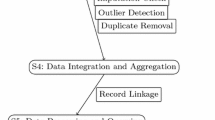Abstract
Nowadays new applications ask for enriching the semantics associated to geographical information in order to support a wide variety of tasks including data integration, interoperability, knowledge reuse, knowledge acquisition, knowledge management, spatial reasoning and many others. Examples of such semantic issues are temporal and spatio-temporal data management, 3D manipulation, spatial granularity and multiple resolutions, multiple representations (providing different perspectives of the same information), vague and ambiguous geographic concepts, the relationship between geographic and physical concepts, and identity of geographic objects through time.
At the same time the recent years brought many developments that radically changed how we understand information processing. Data warehouses and OLAP systems have evolved as a fundamental approach for developing advanced decision support systems. This lead to improved data mining techniques allowing to extract semantics from raw data. Further, the success of Internet has generated a paradigm shift in distributed information processing leading to the area of Semantic Web, in which semantics is the fundamental component for achieving communication both for humans and applications. At the same time, mobile and wireless computing have entered everyone.s life through dedicated devices leading to location-based services. Finally, Grid computing, a paradigm enabling applications to integrate computational and information resources managed by diverse organizations in widespread locations, pushes the frontier of global interoperability. The fact that all these recent developments are entering the geographic domain increases the importance of the elicitation of the semantics of geographical information.
Similar content being viewed by others
Author information
Authors and Affiliations
Editor information
Editors and Affiliations
Rights and permissions
Copyright information
© 2005 Springer-Verlag Berlin Heidelberg
About this paper
Cite this paper
Zimányi, E., Stefanakis, E. (2005). SeBGIS 2005 PC Co-chairs’ Message. In: Meersman, R., Tari, Z., Herrero, P. (eds) On the Move to Meaningful Internet Systems 2005: OTM 2005 Workshops. OTM 2005. Lecture Notes in Computer Science, vol 3762. Springer, Berlin, Heidelberg. https://doi.org/10.1007/11575863_121
Download citation
DOI: https://doi.org/10.1007/11575863_121
Publisher Name: Springer, Berlin, Heidelberg
Print ISBN: 978-3-540-29739-0
Online ISBN: 978-3-540-32132-3
eBook Packages: Computer ScienceComputer Science (R0)




